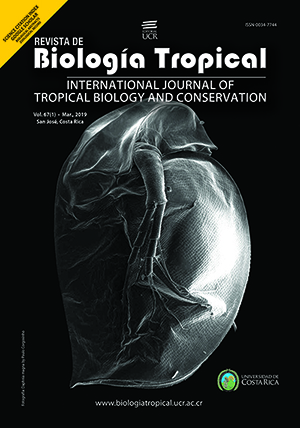Resumen
Lippia origanoides Kunth. es un arbusto medicinal nativo de algunos países de Centro y Sur América y el Caribe. El objetivo de este estudio fue investigar la composición química de los aceites esenciales y la diversidad genética de una población natural de L. origanoides en dos estaciones. El aceite esencial se extrajo en un equipo de Clevenger y se analizó por cromatografía de gases acoplado a espectrometría de masas (CG-EM). La cuantificación relativa de timol y carvacrol se realizó por cromatografía de gases acoplado a un detector de ionización de llamas (CG-DIL). Se utilizó un análisis multivariado para evaluar la divergencia genética entre plantas. El carvacrol fue el compuesto principal encontrado en la mayoría de las plantas para ambas estaciones. En la estación lluviosa, la planta 15 presentó timol como el compuesto principal y las plantas 16, 27, 28 y 29 presentaron alcanfor como el compuesto principal. En la estación seca, el timol se mantuvo como el principal compuesto en la planta 15, de igual manera el alcanfor se mantuvo como el principal en las plantas 16, 28 y 29. Sin embargo, la planta 27 presentó carvacrol como el principal compuesto en esta estación. Después del carvacrol, los compuestos con el mayor contenido fueron γ-terpineno, p-cimeno and metil-eter-timol. De las 30 plantas estudiadas, solo cinco difirieron en su composición química, mostrando algún grado de estabilidad en relación a la estación seca y lluviosa. No hubo variación en los compuestos principales entre las dos estaciones, pero hubo diversidad química entre los compuestos principales. El agrupamiento de Tocher mostró cinco grupos distintos, con el grupo 1 incluyendo la mayoría de las plantas en ambas estaciones, lo cual indica que el periodo del año evaluado no interfiere significativamente con la composición de aceites esenciales en la mayoría de plantas.
##plugins.facebook.comentarios##

Esta obra está bajo una licencia internacional Creative Commons Atribución 4.0.
Derechos de autor 2019 Luciana Mendes Souza, Francine Sousa Alves Fonseca, Julio Cesar Silva, Amanda Silva, Julian Silva, Ernane Martins






